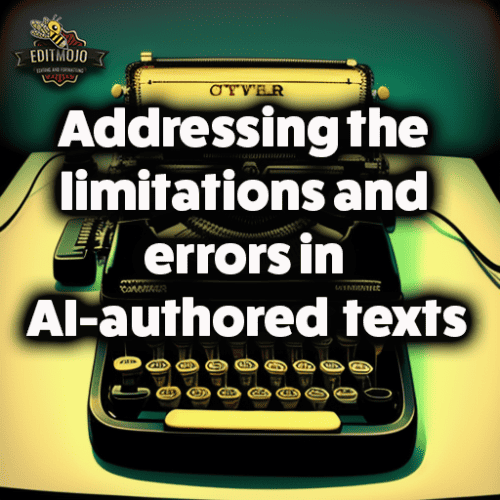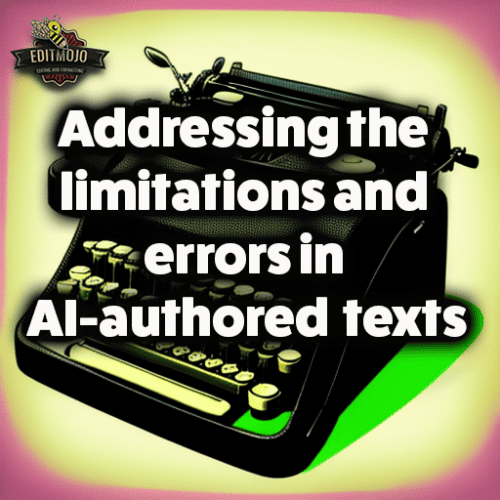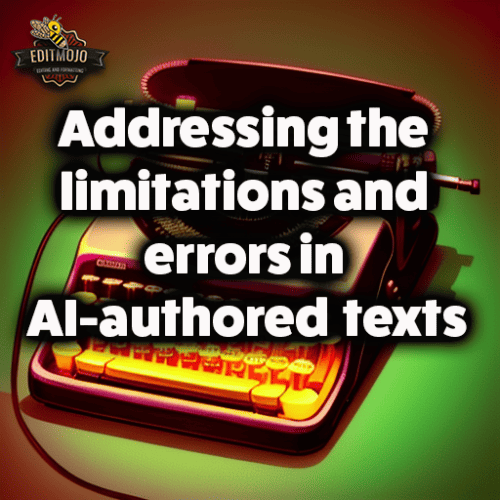Addressing the Limitations and Errors in AI-authored Texts
Addressing the limitations and errors in AI-authored texts. Artificial Intelligence (AI) has made tremendous strides in recent years, penetrating every facet of our lives from personal assistants to self-driving cars. Among its diverse applications, AI’s role in text generation—AI-authored texts, to be specific—has sparked significant interest, and rightly so. With the capacity to generate compelling narratives, answer queries, and even craft poetry, AI text generation brings a new dimension to content creation.
However, as with any technology, it is not without its pitfalls. This article delves into the limitations and errors in AI-authored texts, providing insights into how we might address these challenges.
Key Takeaway Table
| Key Points | Explanation |
|---|---|
| AI’s Role in Text Generation | AI has evolved significantly, from simple chatbots to advanced models like GPT-3 and GPT-4, capable of generating coherent and contextually relevant text. |
| Benefits of AI-authored Texts | AI-authored texts can increase productivity, add creativity, and offer personalization and scalability. |
| Limitations of AI-authored Texts | AI models lack true contextual understanding, original thought, and ability to understand sarcasm and irony. They can also generate misleading information and carry inherent biases. |
| Addressing AI Limitations | Solutions include improving dataset diversity and quality, implementing robust quality control mechanisms, incorporating user feedback, and balancing AI with human oversight. |
| Future of AI in Text Generation | The future will likely see more advanced AI models that minimize current limitations. The evolving role of humans will be crucial, as will be addressing ethical considerations. |
II. Understanding the Role and Growth of AI in Text Generation
The inception of AI in text generation can be traced back to simple chatbots responding to predefined queries. Fast forward to today, and we have AI models like OpenAI’s GPT-3 and GPT-4, capable of generating impressively coherent and contextually relevant text. As we move forward, AI’s role in text generation is only set to expand further.

III. How AI-authored Texts Work
AI-authored texts are largely a product of Natural Language Processing (NLP), a subfield of AI that focuses on enabling machines to understand and generate human language. The current state-of-the-art AI models, like GPT-3 and GPT-4, employ machine learning and more specifically deep learning techniques, using large amounts of data to make accurate predictions.
IV. The Benefits and Potential of AI-authored Texts
There’s no denying the potential and benefits of AI-authored texts. From increasing productivity and efficiency by automating content creation, to adding a touch of creativity and novelty in narratives that might otherwise seem mundane, AI-authored texts offer much to be appreciated. Furthermore, with AI’s capacity for personalization and scalability, generating unique content for every individual user becomes a possibility.
V. Deep Dive into the Limitations and Errors in AI-authored Texts
However, a balanced view requires us to recognize the inherent limitations and errors in AI-authored texts:
Lack of Contextual Understanding
While AI models can generate text based on patterns and contexts from their training data, they lack true comprehension. For instance, they might misunderstand a contextually rich phrase like “it’s raining cats and dogs” as an actual meteorological event involving pets!
Absence of Original Thought and Critical Thinking
AI models, despite their complex algorithms, are essentially glorified pattern recognizers. They do not possess original thought or the ability to critically analyze information. If asked for an opinion, they merely reflect what’s been fed into them.

Inability to Grasp Sarcasm, Irony, and other Subtleties
Sarcasm and irony, often used in literature and daily conversation, are lost on AI. As these nuances heavily depend on tone and context, AI can easily misconstrue them, leading to miscommunication.
Propensity to Generate Inaccurate or Misleading Information
Without the ability to verify the truthfulness of their output, AI can generate incorrect or misleading information. This is particularly worrisome when it comes to sensitive topics like health or legal advice.
Ethical and Bias Issues
AI models are as good or as bad as the data they are trained on. If the training data contains biases or stereotypes, these can inadvertently get reflected in the generated text.
VI. Case Studies Demonstrating AI Limitations and Errors
One of the most telling cases is the translation error made by AI, where a Chinese phrase meaning “I’m fed up” was translated to “I’m pregnant” in English, leading to quite a comedic mix-up! Similarly, there have been instances where AI systems have propagated stereotypes, reflecting the bias present in their training data.
VII. Steps to Address these Limitations and Errors
Improving Dataset Diversity and Quality: One of the primary steps towards addressing these limitations is by improving the diversity and quality of the datasets used for training AI models. This can help in minimizing bias and enhancing the accuracy of AI outputs.
Implementing More Robust Quality Control Mechanisms: By incorporating strict quality control measures, the likelihood of AI generating inaccurate or misleading information can be significantly reduced.
Incorporating User Feedback for Continuous Learning: Users interacting with AI-authored texts can provide valuable feedback, which can be used to improve the model’s performance.
Balancing AI with Human Intervention and Oversight: While AI can automate content creation, the role of human oversight in reviewing and refining AI outputs cannot be overemphasized.

VIII. The Future of AI in Text Generation: Addressing Limitations and Errors
As we step into the future, it is expected that more advanced AI models will emerge, capable of minimizing current limitations and errors. The human role in text generation will evolve too, from creators to curators and overseers. However, as technology advances, the ethical considerations surrounding AI text generation become ever more crucial.
IX. Conclusion (Addressing the limitations and errors in AI-authored texts)
In conclusion, AI-authored texts offer immense potential, yet they are not without their limitations and errors. As we harness the potential of AI, it’s equally important that we address its inherent limitations. For, as Arthur C. Clarke aptly said, “Any sufficiently advanced technology is indistinguishable from magic, but it is up to us to keep the magic in check.”
X. References (Addressing the limitations and errors in AI-authored texts)
Top Five Questions and Answers
Q1: What are the limitations and errors in AI-authored texts?
A1: Limitations and errors include a lack of true contextual understanding, absence of original thought, inability to grasp sarcasm and irony, a propensity to generate inaccurate or misleading information, and potential ethical and bias issues.
Q2: How can we address these limitations and errors in AI-authored texts?
A2: Solutions include improving the diversity and quality of datasets used for training AI models, implementing robust quality control mechanisms, incorporating user feedback for continuous learning, and balancing AI with human oversight.
Q3: What benefits do AI-authored texts offer?
A3: AI-authored texts can increase productivity and efficiency by automating content creation, add creativity and novelty to narratives, and provide personalization and scalability for unique content creation.
Q4: How does AI generate text?
A4: AI-authored texts are a product of Natural Language Processing (NLP), where machine learning and deep learning techniques are employed. These models, such as GPT-3 and GPT-4, use large amounts of data to generate text based on recognized patterns and contexts.
Q5: What does the future hold for AI in text generation?
A5: The future will likely see more advanced AI models capable of minimizing current limitations. The role of humans in text generation will also evolve, from creators to curators and overseers. Ethical considerations surrounding AI text generation will become increasingly crucial.
